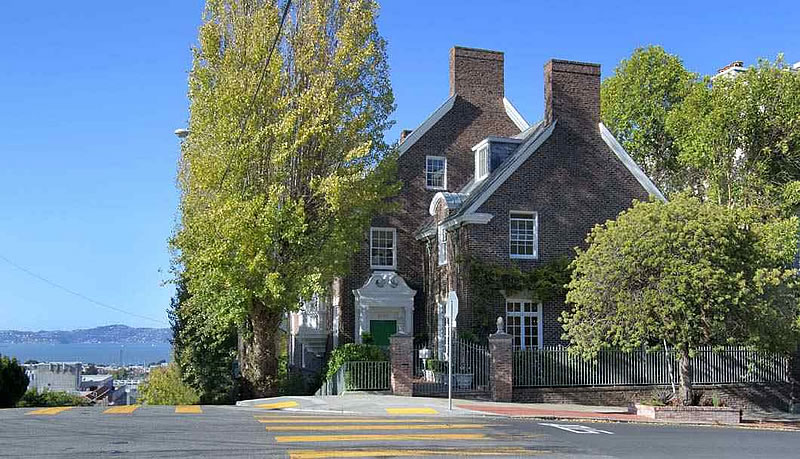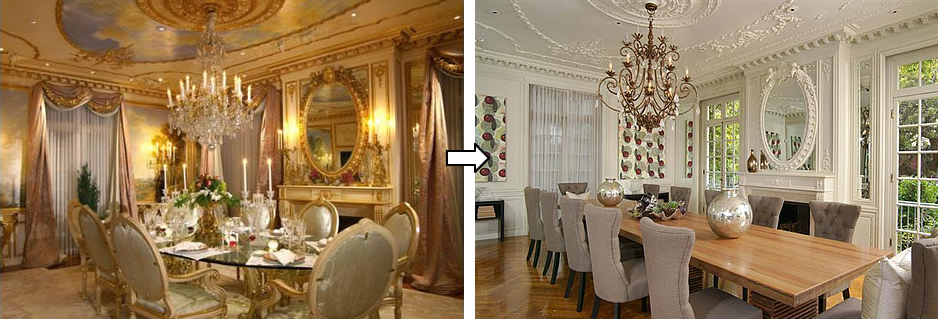Having been on and off the market for the past seven years and originally listed for $17,800,000, the Pacific Heights home at 2090 Vallejo Street has closed escrow with a reported contract price of $9,500,000, making it the most expensive home sale in San Francisco last month.
Designed by Clarence Tantau for City of Paris founder Benjamin Schlesinger in 1919 and then restored by European craftsman at a cost of over three million dollars in 1993, the original listing for the 10,340 square foot home boasted an “exquisite jewel-like interior including lavish wall panels, columns, extraordinary three-dimensional moldings, impressive Frescos and opulent 24-carat gildings.”
With the “jewel-like interior, lavish wall panels, impressive Frescos and opulent 24-carat gildings” since painted over, the property returned to the market last year listed for $10,950,000 and was reduced to $9,950,000 in May.


WTF…..they painted it over?
They painted over all of the gilding. Wow.
Hard to believe they painted over that. No wonder they did not get the original asking price.
But it truth, this remodeling of the dining room is part of the trend of what people are doing to homes in SF. In smaller, more modest homes they knock out walls and create the same interior over and over again making everything vanilla. But this is really astounding. It could have been very cool with modern furniture and the original walls, frescos, gold and all.
How terribly sad and awful, from fabulous to barely restoration hardware
Guess nobody wants to live like Liberace these days.
This was another of a long line of real SF houses that have been mistreated in the bizarre belief that luxury and decoration are past. Aside from the ancient (perhaps genetic) interest of women in beautifying themselves, nothing is as basic to human nature as embellishing a dwelling place.
In a short time, SF will begin to regret this ongoing destruction of its residential property heritage.
There are many houses in SF which are being restored after this sort of desecration, and it is very expensive.
Does our wise colleague from southern California have a comment on this?
That gold dining room would have made me gag every time I walked into it. Pretty generic now, I agree, but far superior to that gilded waste-of-money atrocity. I get that it was campy and over-the-top and funny and all that. But nobody in their right mind would want to live with that. That said, I think they probably could have kept the ceiling fresco (or painting — can’t tell) and it would have looked okay with the lighter-colored ceiling and walls.
Agree. I’m all for retaining classic architecture, but I like the painted dining room much better. The old one is ridiculous. I’d be embarrassed to host people in a space like that. No one with taste would be restoring a room to look like the “before”, expect maybe the fresco.
The question is what it looked like when it was built. When you buy a house like this, you are buying a piece of history; if you do not like history, do not buy this house. There are plenty of white cubes available for people who want to life in contemporary austerity.
Boy, when our Victorian was built, I’m not sure it had electricity, indoor plumbing, telephone lines, a gas furnace, a water heater, lead-free paint, or insulation. I guess I should rip all that out in the name of the debt to history that I owe. Come on, saying that someone “should not buy” a house if they intend to change it is really rather over the top. Everyone is entitled to his/her interior decorating taste, but the property owners’ taste trumps all others’ obviously. And in this case, it is pretty clear that nobody was interested in paying this sum and keeping that hideous tribute to Uday, Qusay, and Michael Jackson.
i love that place. The view in and of itself…
Could not put it any better than JR. I was really surprised to see the first several comments actually bemoaning the “loss” of that tacky monstrosity. Embarrassing is exactly right.
Imagine if a buyer in Santa Barbara/Montecito was looking for a George Washington Smith Spanish/Colonial home, but every time they stepped into a new listing preview tour, they found the homes were all stripped of any authentic historic character and instead were made acceptable to what some flipper/builders think buyers want. Walls were removed, moldings hidden in layers of white paint, historic tile removed for the latest countertop surface fad material.
Or a craftsman in the Berkeley/Claremont hills or Pasadena having all their interior wood trim painted white.
Or a mid-century modern home in the Hollywood Hills being changed to cover all of the original interior steel and wood with gyp and paint.
Conifer is right, we are losing our heritage and I can think of no city that is doing a better job of turning its back on what made it unique. I was just in Chicago and had a chance to see the Driehaus mansion which opened my eyes to a period of style I had never found interesting and was prejudiced by previous images that made it look gaudy and tasteless, but in person, it was a fantastic visual experience I will never forget.
This is all beside the point, because there was no buyer looking for the Liberace/Louis XIV version of this house. It was on the market for years in that form with no takers. What are you proposing exactly — that the sellers were somehow indebted to retain indefinitely an asset they did not want to hold until the one guy who has $10M+ to spend on a house, wants to live in that neighborhood, and actually wants the style that had been rejected by the market for seven years comes along?
I understand the criticism of the new version as bland, but the fact is that this is not just “what some flipper/builders think buyers want”; it is in fact what actually buyers bought, whereas no buyer bought the other version. No need for hypotheticals.
So, you think painting over the dining room had more effect in attracting a buyer than dropping the price by $8,000,000.00?
It went through multiple de- and re listings price reductions in 2007-2008 before they made the changes to the house. We’re back into hypotheticals here but my money on what would happened if they’d immediately dropped the price all the way down and sold it without the changes would be on the new buyers getting rid of the former kitsch themselves.
“No one with taste would be restoring a room to look like the “before”, expect maybe the fresco.”
Guess you’ve never been to Paris, Berlin, Rome, Venice, Vienna……
I have actually. But this is a dining room in San Francisco. Besides, they painted over the gold and opened up the windows so the room gets natural light. This wasn’t turned into some stark modernist box, as conifer suggested further up. This room was silly and over the top when built. It’s no great loss to the character of the city.
There are plenty of old houses that have their charm and character, but often they have dated details or awkward layouts that people don’t want anymore. Sometimes it’s tiny rooms, sometimes poor light, sometimes infrastructure upgrades, etc… I’m sure no one is upset that the owners might have replaced the original kitchen in this place. You just do that over time. This dining room is still a unique room in its current form – it just doesn’t give you a headache.
My comment was directed not so much at the dining room of this house in particular, but at the state of San Francisco historic home interiors in general. Also, sometimes images do not convey the true atmosphere of certain interiors. I recently was in a Ernest Coxhead home in Presidio Heights that had much of the interior wood trim painted white or gray and I truly wanted to weep.
As for this home, I believe Cynthia used to have many dinner parties in the dining room with real candlelight which looked fantastic if you were able to sneak a glance while passing by outside in the evening. This is not my taste, but how is painting over everything in white a better solution?
I don’t understand why so many people are criticizing this remodel. The truth is all of the gilt with the draperies and the “Louie” whatever chairs was horrible. Unlike some many other remodels, they kept the mouldings and rooms intact.
Still waiting for one of the preservationists-above-all-else to complain about getting rid of the wall-to-wall carpet in the dining room. All that authentic historic character lost!
I’m just happy this place finally, finally has an owner and that it sold for a decent price. I have no information on this, but I highly doubt the frescoes, puti, and gilt everything were original to the house. It’s always come across less Louis XVI and more Michael Jackson 1997. I’m sorry if that’s overly snarky, but the relatively simple, formal exterior seemed incongruous to the Paris® Las Vegas Hotel interior. I think the buyers have moved in, but it wouldn’t surprise me if this place was gutted in a year or so once permits are approved, then whining can officially commence. That said, I understand the plight of the preservationists… I’ve seen way too many lovely, historical homes in this area turned into really expensive McMansions. I think there could be some effort to make a more harmonious blend of classic San Francisco interiors and those that fit a more modern lifestyle. But, I also understand this is a business. These homes were designed for the tastes of the day, just as they are being updated for the tastes of the present. We have the original listing pictures and can just move on… It’s entirely likely in 100 years someone will unearth the archived pictures are turn it back into… well whatever this was.
Honestly though, I’ve been in enough of these mansions over the last decade or so that I can say with some authority that most don’t have the type of luxury finishes that you would expect. In many ways, these were the McMansions of their day, a poor facsimile of Baroque or Edwardian style. We all know the truly great mansions were destroyed almost in 1906. What came after often seemed to be just as much an imitation of grandeur as the Panama-Pacific Exhibition. Take 2898 Vallejo, for example. It’s… a total dump.